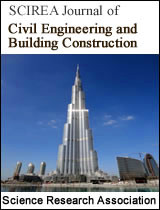Study the effect of foundry sand and rice hull ash on the mechanical and microstructural properties of concrete
DOI: 427 Downloads 14235 Views
Author(s)
Abstract
Waste foundry sand, often piled in a large amount in the enclosures of the foundries, is the by-product of metal casting industry. Rice hull which is often burned after it is removed from rice is also a by-product of the agriculture industry. Disposing of these wastes leads to the environmental pollution. To optimal use of these wastes and avoid the adverse effects of dumping them, regular sand has been partially replaced with the waste foundry sand and rice hull ash pozzolana has been also used as a partial replacement for cement in making concrete. XRF and XRD experiments were conducted to study the chemical structure of waste foundry sand and rice hull ash. To assess the strength properties, compressive strength, tensile strength (Brazilian), flexural strength, modulus of elasticity and water absorption tests have been conducted. SEM test was carried out on concrete samples to determine the micro-structural characteristics. The results showed a slight decrease in compressive strength of samples in which regular sand was replaced with waste foundry sand by 15 percent; however, adding the rice hull ash to this mixture led to make a concrete comparable with control one.
Keywords
recycled materials concrete, waste foundry sand, rice hull ash, strength properties
Cite this paper
Ali Seyedkazemi, Meysam Mirzaeipour, Saman Eftekhar Ardabili,
Study the effect of foundry sand and rice hull ash on the mechanical and microstructural properties of concrete
, SCIREA Journal of Civil Engineering and Building Construction .
Volume 3, Issue 2, April 2018 | PP. 12-33.
References
| [ 1 ] | Naceri, A. and Chikouche Hamina, M., “Effects of pozzolanic admixture (waste bricks) on mechanical response of mortar”, International Journal of Engineering Transactions B: Applications, Vol. 21, No. 1, (2008), 1-8. |
| [ 2 ] | Shafabakhsh, G. and Ahmadi, S., “Evaluation of coal waste ash and rice husk ash on properties of pervious concrete pavement”, International Journal of Engineering Transactions B: Applications, Vol. 29, No. 2, (2016), 192-201. |
| [ 3 ] | Sharma, S., Gupta T. and Sharma R. K., “Assessment of mechanical properties of concrete containing granite slurry waste”, International Journal of Engineering Transactions B: Applications, Vol. 29, No. 5, (2016), 599-605. |
| [ 4 ] | Zerbino, R., Giaccio, G. and Isaia, G. C., “Concrete incorporating rice-husk ash without processing”, Construction and building materials, Vol. 25, No. 1, (2011), 371-378. |
| [ 5 ] | Kumar, D. P., Eswaramoorthi, P. and Baby, B., “Strength Characteristics of Structural Concrete Elements Using Foundry Sand”, International Journal of Engineering Research and Applications, (2014), 64-68. |
| [ 6 ] | Basar, H. M., Aksoy, N. D., “The effect of waste foundry sand (WFS) as partial replacement of sand on the mechanical, leaching and micro-structural characteristics of ready-mixed concrete”, Construction and Building Materials, Vol. 35, (2012), 508-515. |
| [ 7 ] | Sohail, M., Wahab, A. and Khan, M. A., “A Study on the Mechanical Properties of Concrete by Replacing Sand with Waste Foundry Sand”, International Journal of Emerging Technology and Advanced Engineering, Vol. 3, No. 11, (2013), 83-88. |
| [ 8 ] | Singh, G. and Siddique, R., “Effect of waste foundry sand (WFS) as partial replacement of sand on the strength, ultrasonic pulse velocity and permeability of concrete”, Construction and Building Materials, Vol. 26, No. 1, (2012), 416-422. |
| [ 9 ] | ASTM E1621-13, “Standard Guide for Elemental Analysis by Wavelength Dispersive X-Ray Fluorescence Spectrometry”, West Conshohocken, PA, (2013). |
| [ 10 ] | BS EN 13925-1:2003, “Non-destructive testing. X-ray diffraction from polycrystalline and amorphous materials. General principles”, London, British Standards Institution (BSI), (2003). |
| [ 11 ] | ASTM C150 / C150M-17, “Standard Specification for Portland Cement”, West Conshohocken, PA, (2012). |
| [ 12 ] | Salokhe, E. P. and Desai, D., “Application of foundry waste sand in manufacture of concrete”, in Second International Conference on Emerging Trends in Engineering (SICETE), India, (2011). |
| [ 13 ] | Guney, Y., Sari, Y. D., Yalcin, M., Tuncan, A. and Donmez, S., “Re-usage of waste foundry sand in high-strength concrete”, Waste Management, Vol. 30, No. 8-9, (2010), 1705-1713. |
| [ 14 ] | Prabhu, G. G., Hyun, J. H. and Kim, Y. Y., “Effects of foundry sand as a fine aggregate in concrete production”, Construction and Building Materials, Vol. 70, (2014), 514-521. |
| [ 15 ] | Saraswati, C. P., Jaykrushna, K. R., Palas, A. S., Jay, G. M. and Ankit, N. P., “Application of Waste Foundry Sand for Evolution of Low-Cost Concrete”, International Journal of Engineering Trends and Technology (IJETT), Vol. 4, No. 10, (2013), 4281-4286. |
| [ 16 ] | BS 1881: Part 122, “Methods for determination of water absorption”, London, British Standards Institution, (1881). |
| [ 17 ] | Hewlett, P.C., “Lea's chemistry of cement and concrete”, United Kingdom, Butterworth-Heinemann, (2003). |
| [ 18 ] | Aggarwal, Y. and Siddique, R., “Microstructure and properties of concrete using bottom ash and waste foundry sand as partial replacement of fine aggregates”, Construction and Building Materials, Vol. 54, (2014), 210-223. |

